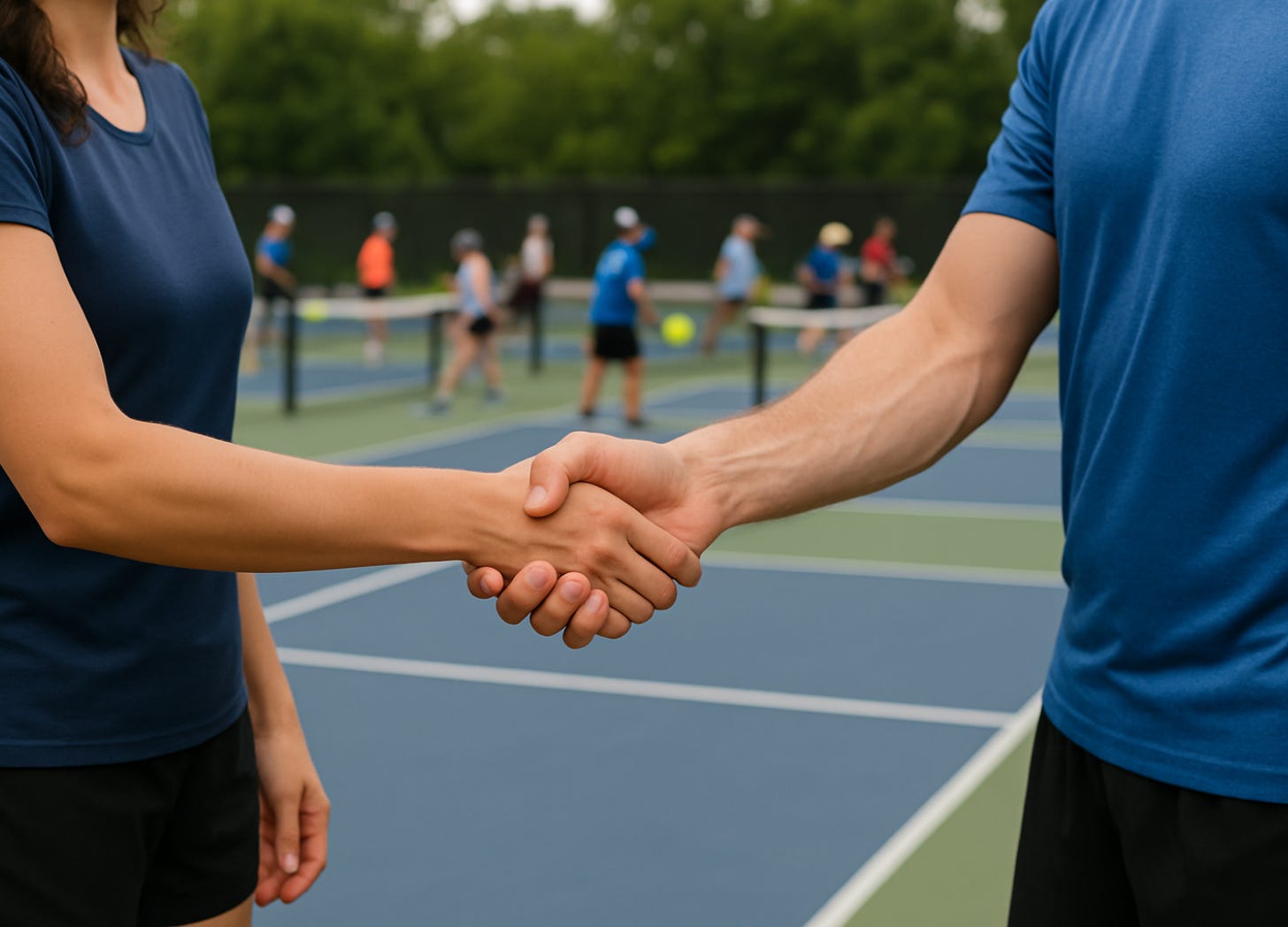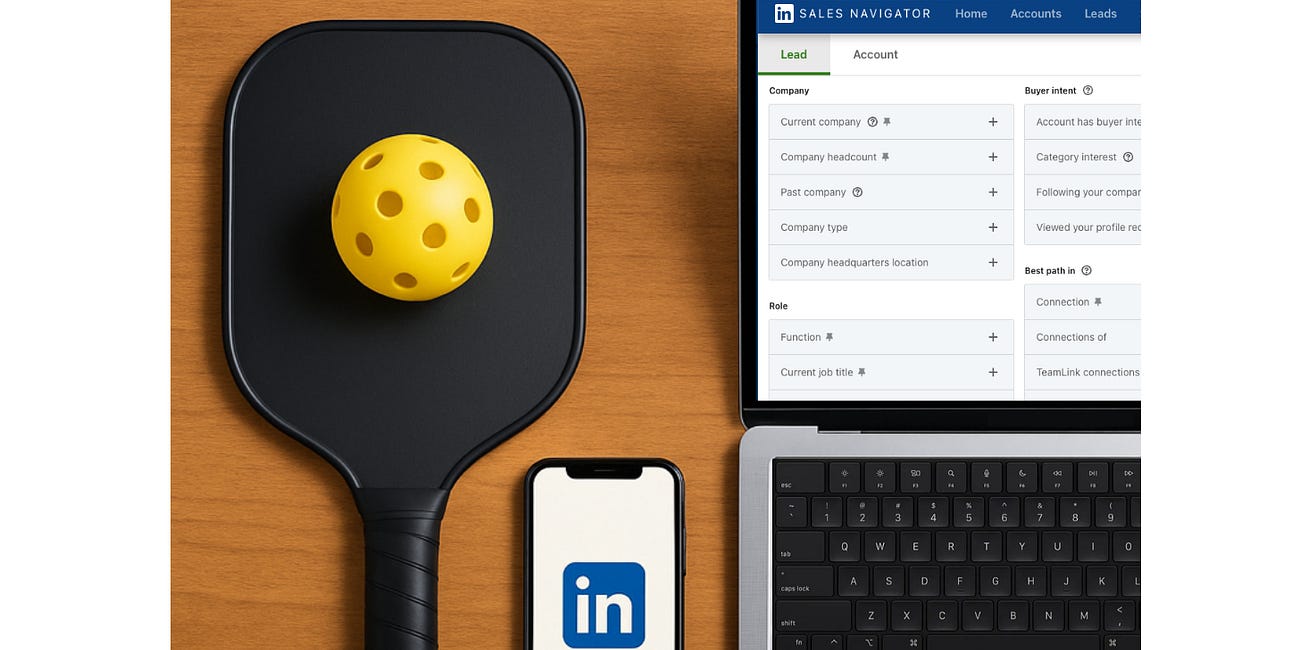Pickleball and the Networking Lessons for Sales
Why the "new golf" and the world’s fastest-growing sport is also a masterclass in connection, mindset, and selling.
The TL;DR (Executive Summary)
Open play in pickleball is unique: anyone can drop in, rotate games, and potentially meet dozens of people in a single session.
Networking advantage: Unlike golf or tennis, pickleball is designed for mixing, making it one of the best sports for meeting new professionals. (It’s already been called “the new golf” for a reason.)
Whole-brain workout: Racket sports improve quick thinking, strategic planning, and memory while lowering cognitive decline risk… meaning you sharpen your brain while expanding your network. It’s a win-win.
Sales parallel: Just like open play, effective social selling means showing up, rotating conversations, and building trust over time.
Key takeaway: If you want fitness, fun, professional connections, and sales lessons all in one, pickleball delivers.
I’ve only recently dipped my toes into pickleball open play. Honestly, I expected just a good workout and some fun, while at the same time praying the ball went over the net and stayed in bounds. What I didn’t expect was how quickly I was meeting new people, professionals, business owners, and people from all walks of life.
In one setting, I can rotate through multiple games while playing with and against people I’d never met before. By the end, I (and you!) can be sweaty and tired… and have gained some new connections in the process.
It struck me that pickleball, particularly through open play, is probably a better networking sport than golf or tennis. (It’s already been called the “new golf” when it comes to networking and meeting people.) And it’s teaching me lessons that apply directly to how we sell and connect.
What Is Open Play… and Why It Matters
Open play in pickleball is simple: you show up, put your paddle in a rotation system, and mix into games with whoever’s up next. Games are short, usually to 11… so you’re constantly rotating partners and opponents.
Contrast that with other sports:
Golf: Networking’s classic home. It’s been quite a while since I’ve played it, but I still love it. Thing is… you need to organize a foursome in advance, block off 4+ hours, and most of the networking happens after the round at lunch or the proverbial “19th hole.”
Tennis: Like golf, tennis at the amateur level is mostly pre-arranged matches. A few clubs offer mixers, but there’s no standing culture of rotation and open play like there is in pickleball.
Pickleball: Built for it. Drop in, play, rotate, connect. Everyone’s included, no partner required.
This structure makes pickleball a natural community-builder. It lowers the barrier to entry, accelerates connection, and turns a casual-ish workout into a networking engine.
The Dual Advantage: Networking Meets “Whole-Brain” Fitness
a) Social & Professional Platform
Because games are short and rotations are constant, you meet more people in an hour of pickleball than you might meet in an entire golf outing. Each game gives you a small shared experience with partners and opponents alike. It’s an instant icebreaker.
And unlike golf, you don’t have to wait until the clubhouse to connect. The conversations happen right there on the court, between points, while rotating in and out, or afterwards.
b) A Workout for the Body and Brain
Pickleball isn’t just great for networking. It’s also a powerful whole-brain workout. Neuroscience shows that racket sports engage multiple areas of the brain -- quick thinking, strategic planning, spatial awareness -- while also improving memory, focus, and mood. The mix of movement, decision-making, and social interaction stimulates neuroplasticity and may even delay age-related cognitive decline. Hey, it’s science!
That’s a big bonus for me. While you’re building professional connections, you’re also strengthening the very cognitive skills that make you sharper in business and sales conversations. You may want to read my previous post on pickleball and sales to examine that angle further:
What Pickleball Is Teaching Me About Sales
I’ll admit it… I’m hooked. Like, hook-line-and-sinker hooked.
The Big “So What?”
The more I’ve thought about open play, the more I’ve realized it’s also a metaphor for how modern sales, especially social selling, actually works.
1. Show Up Consistently
In open play, you can’t meet anyone if you don’t show up. In sales, you can’t build trust if you’re only visible on LinkedIn once in a while. Consistency is what gets you in the rotation. So sign up for open play if you belong to a club or facility, or just show up if you play at a public park. And for LinkedIn, remember the 10:1 rule: for every post you publish, you should comment (with value!) on at least 10 posts from other people.
2. Rotate Conversations
Pickleball mixes you with new people every game. Sales Navigator does the same by surfacing new decision-makers through saved searches and alerts. And just like the court, sales requires you to mix in: comment on different posts, join conversations, and message new prospects.
3. Build Rapport Quickly
One game of pickleball builds camaraderie with strangers. In sales, one thoughtful comment or shared insight can break the ice with a potential buyer. Both environments accelerate connection. So… do it!
4. Accept That Not Every Game Leads to a Win
In open play, you won’t win every game. In sales, you won’t close every deal. The mindset shift is the same: keep playing, keep learning, keep showing up. Over time, you win more than you lose.
Networking doesn’t always have to happen in a conference room, on a golf course, or over a pre-arranged coffee. Sometimes the best opportunities come from showing up where people already gather, mixing in, and letting the shared experience spark the connection.
Pickleball proves that. And so does social selling.
Where have you found your best “unexpected networking arenas”? Drop a comment or reply… I’d love to compare notes. I know that pickleball isn’t the only place to network. But with its huge growth in popularity, it’s likely attracting the people you’d like to connect with.
P.S.: I promise to get back to LinkedIn/AI-specific content next week. I just had to get this last pickleball-focused piece out of my head before I could do that.
(NOTE: The hero image for this post was generated by AI, which [this time] did an excellent job of things without any of my terrible Canva post-generation editing.)



